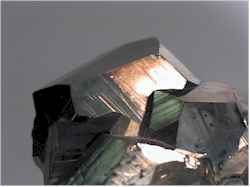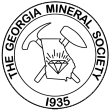Pyrite
"Some Little-Known Facts"
By
Holly Camp

I’m a "Green" person. I love the color! So, how is it that pyrite is one of my favorite minerals? I have more pyrite specimens than I have malachite, emerald, dioptase and tsavorite combined. Now, that’s saying a lot! Instead of what the average mineral book could teach you, I would like to tell you about some unusual information I have learned about pyrite.
The ancient Greeks called it ‘pyr’ which means fire and ‘ite’ which means stone. ‘Pyrites lithos’ refers to the "spark produced when iron is struck by a lump of pyrite." If you try this experiment at home, please don’t use a good specimen. Remember, pyrite is brittle.
While you’re at it, why not check to see why a pyritohedron is so special and why pyrite pseudomorphs turn into limonite.
Surprise! Pyrite is in the Pyrite Group. There are only five other minerals in that Group. Some of them are very strange. Penroseite is only found in Bolivia and England. Sperryliteis extremely rare because it’s the only known compound of platinum. Laurite contains ruthenium (atomic #44 on the Chart of Elements) and is only found in South Africa, Canada, Sierra Leone, the former USSR, the United States, and Borneo. Bravoite is a nickeloan pyrite. Just for fun, go ahead and look up these minerals and see just how odd they really are. Compare their specific gravities and Mohs hardnesses. Go on! It’s worth it! Pyrite, an iron sulfide, and hauerite, a manganese sulfide, seem tame in comparison to the rest of this Group.
If you have been to Graves Mountain and the Little Bob Mine in Georgia, then you know about the problems associated with pyrite. When this combination of iron and sulfur (FeS2) weathers, the iron oxidizes (rusts away) and the sulfur combines with rain and ground water. The result of that is sulfuric acid. You can even smell it. And, be careful not to kneel down there. It will eat through your jeans in no time. I speak from experience.
For a moment, think about all the people who thought pyrite was just "Fool’s Gold". How little they knew! Did you know that gold, real gold, is found in most pyrite deposits around the world? If it’s a major pyrite deposit and if there is a large enough percentage of gold, then it may be mined for its gold content, as well as iron and sulfur.
However, pyrite has a much more important use! More important than gold? Oh, yes. Our lives would be totally different without this one thing made from pyrite: SULFURIC ACID. I know you’re wondering why. Did you know that sulfuric acid is the second most important industrial chemical (water is first). This acid was first produced around 1000 AD. Here is a short list of where it is used today: in petroleum refining, as a drying agent to remove water from sugars and starches, superphosphate fertilizer, alcohol, rayon, nitric acid, paints, dyes, explosives, detergents, paper pulp, lead/acid batteries, rubber, pharmaceuticals, metallurgical processes, cellophane, and pesticides. You can even thank pyrite for the brown color of your beer bottle.
Close to home, a perfect example of the importance of pyrite (and its ‘cousin’ chalcopyrite) is found in Ducktown and Copperhill, Tennessee. Originally, the mines were opened to extract copper and iron. Eventually, copper became too expensive to mine there, so the real value of the pyrite was realized. Pyrite was mined there and processed into sulfur and sulfuric acid until 1987.
But, it’s the different "looks" of pyrite that captivate me. Just remember, strange things can occur as these crystals are forming. We most commonly see the smooth-sided or striated-sided cubes. Pick one up sometime and really examine it. I can tell you’re interested. Now, open a book on minerals and take a look at some of the other crystal forms of pyrite. You’re blood-pressure just went up a notch. Take a look at the "penetration twins" from Spain. These pieces are dissolved out of the native limestone. This is just the way they formed! It looks like an artist worked on them to ‘stand’ that way. Feeling weak-kneed yet? And, then, there are "Suns". These occur as the dissolved pyrite starts to drip down through layer after layer of shale, it forms concentric "puddles", also known as "Suns". There has been much discussion lately as to whether these are more pyrite than marcasite. Time will tell and so will the experts.
If you collect pyrite, either by the "pick-it-up-yourself" or "green collected" method, you will also fall for this normally brassy yellow mineral. Just wait until you see specimens that are tarnished!

Copyright © Georgia Mineral Society, Inc.
